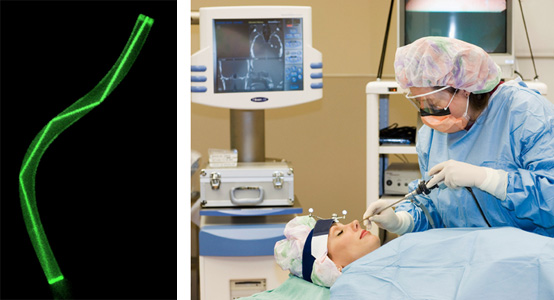Fiber optics is a branch of physics based on the transmission of light through transparent fibers of glass or plastic. These optical fibers can carry light over distances ranging from a few inches or centimeters to more than 100 miles (160 kilometers). Such fibers work individually or in bundles. Some individual fibers measure less than 0.00015 inch (0.004 millimeter) in diameter—thinner than a human hair.
Optical fibers have a highly transparent core of glass or plastic surrounded by a covering called a cladding. Light impulses from a laser, a light bulb, or some other source enter one end of the optical fiber. As light travels through the core, the cladding typically keeps it inside. The cladding is designed to bend or reflect—inward—light rays that strike its inside surface. At the other end of the fiber, a detector, such as a photosensitive device or the human eye, receives the light.
Kinds of optical fibers.
The two basic kinds of optical fibers are single-mode fibers and multi-mode fibers. Single-mode fibers are used for high-speed long-distance transmissions. They have extremely small cores, and they accept light only along the axis of the fibers. Tiny lasers send light directly into the fiber. Low-loss connectors may be used to join fibers within the system without significantly degrading the light signal. Such connectors also join fibers to the detector. Multi-mode fibers have much larger cores than those of single-mode fibers, and they accept light from a variety of angles. Multi-mode fibers can use more types of light sources and cheaper connectors than can single-mode fibers, but they cannot be used over long distances.
Uses of optical fibers.
Optical fibers have a number of uses. Industries use them to measure temperature, pressure, acceleration, and voltage. In fiber-optic communication systems, lasers transmit messages in digital (numeric) code by flashing on and off at high speeds. Such a code may represent a voice, or an electronic file containing text, numbers, or illustrations. The light from many lasers can be added together onto a single fiber. This enables thousands of “streams” of data to pass through a single fiber-optic cable at one time. The data travel to interpreting devices that convert the messages back into the form of the original signals.
Fiber-optic communication systems have a number of features that make them superior to systems that use traditional copper cables. Besides having a much larger information-carrying capacity, they are not bothered by electrical interference and require fewer amplifiers than copper-cable systems of equal length. Many communication companies have installed large networks of fiber-optic cables across the continents and under the oceans.
Optical fibers are well-suited for medical use. They can be made in extremely thin, flexible strands for insertion into the blood vessels, lungs, and other hollow parts of the body. Optical fibers enable physicians to look and work inside the body through tiny incisions. Instruments called endoscopes carry two bundles of optical fibers inside a long tube. One bundle directs light at the tissue being examined. The other transmits light reflected from the tissue, producing a detailed image. Endoscopes may be designed to look into specific areas. For example, physicians use an arthroscope to examine knees, shoulders, and other joints (see Arthroscopy).

Optical fibers also can be used to measure temperature and other bodily properties. They can be inserted into blood vessels to give a quick, accurate analysis of blood chemistry. Another medical use is to direct intense laser light that stops bleeding or burns away abnormal tissue.
